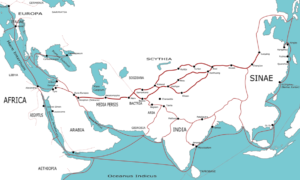
Pakistan, owing to its geographical location is in an ideal position to serve as a corridor to Central, South, East and West Asia. Not only does it provide easy trade links to these regions but has the potential to provide a convenient transit route too. This is one of the major reasons why Pakistan has always figured importantly in the regional and global politics.
The fact that it is located adjacent to world’s largest economies further elevates its status as a significant geostrategic location. Even though Pakistan’s economic indicators have not have been very hopeful in the past but with the CPEC unfolding fast and meeting its deadlines, Pakistan can prove to be a potential regional geographic hub by connecting and integrating the regional economies.
However, having the potential and tapping it to one’s advantage are two different things. The concerned authorities really need to look into the troubled areas and devise pragmatic policies to take advantage of this potential i.e. strategic location and geography. For now, even though the CPEC remains largely bilateral as is also evident from its nomenclature, its inclusivity cannot be ignored. Time and again there have been statements by the Chinese leaders where all and any country is welcomed to join the CPEC if they wish to. This might practically materialize at some later stage when CPEC; the flagship project of BRI starts to deliver.
While still in the developing stage it has managed to attract worldwide attention wherein large number of countries has shown the inclination to join. These countries include Russia, United Kingdom, France, Germany, Romania, Belarus, Ukraine, Italy, Saudi Arabia, United Arab Emirates, Iran, Turkey, Afghanistan, and the Central Asian Republics etc. Hence, once the CPEC is fully completed, it will be able to embrace in its folds several other countries into a mutual network of economic and security cooperation.
Therefore, this aspect of expanding the CPEC to the adjacent economies is not only doable but already under consideration. CPEC could then be specifically expanded to the neighboring economies of Central Asia, West Asia, Afghanistan, and India. In such an arrangement, the Central Asian energy markets will not only be easily accessible but it will provide the resource-rich landlocked Central Asia states to reach the markets in Pakistan, China, West Asia and India and an access to the warm waters. Once these goods have a larger outreach, it will foster the regional and global economic trade as well as connectivity.
The possibility for the CPEC to be extended to Central Asia, Afghanistan and India have already been mentioned by President Xi Jinping during his address to the Pakistani parliament on his first visit to Pakistan in April 2015. He welcomes the regional economic integration and believes that the changing geopolitical requirements demand to a reshuffle of policies. The same realization is there in the official circles of Pakistan that the reorientation of its regional and global economic policies focusing on the export-oriented framework to the new global markets including the Indian markets in order to uplift its economy is the need of time. China-Pakistan trade volume is not too satisfactory at the moment, so the expansion of CPEC to India will only enlarge the volume of overall regional trade between China, Pakistan, and India. CPEC provides an excellent opportunity to Pakistan to extend trade to South and Central Asia including India.
This is especially true as the US rebalancing policy and Trans-Pacific treaty in Asia Pacific region include, military, economic and strategic cooperation with the South East Asian states including India against China. This eventually raises alarm for China. Gwadar port is 400 km away from the Strait of Hormuz. This allows China to transport its good at a much lesser distance which would be reduced from 12000 km to only 3000 km. In this way, the Chinese goods to the West Asian markets can be made available in much lesser time, at a much lesser cost of travel, and also bypassing the congested Malacca Strait. This not only ensures the economic security i.e. unhindered flow of economic goods but allows China to address its Malacca Dilemma.
For now, India has been working on an alternative access point i.e. Chabahar port to reach West Asia, Central Asia, and Afghanistan. This is understandable given the long history of rivalry between Pakistan and India where Pakistan naturally feels reluctant to give a free passage to India through its soil. This move to bypass Pakistan has become more evident in the wake of trilateral framework between India, Iran, and Afghanistan for economic cooperation. Nonetheless, such strict positions and distrusts need to be mitigated and instead the regional dividends for all should be made the bigger cause.
One possibility could be to make Gwadar and Chabahar ports into regional imports, including other regional states in them to increase the regional trade. Iran has floated this idea to Pakistan regarding the Chabahar port while Pakistan has also reassured to India that Gwadar should not be seen as the rival port but a regional port instead.
Pakistan on its part should give importance to the successful and timely materialization of the CPEC and then focus on making it’s regionally inclusive. As the Federal Minister for Planning, Development, and Reform, Ahsan Iqbal, mentioned that Pakistan had achieved 5% economic growth and is now able to create a favorable socio-economic ecosystem that enjoyed political stability. A favorable ecosystem is what the country needs to continue to focus on in order to attract the interest of key global investors which are now eying Pakistan as a potential market for investments. China is promoting regional and global connectivity across the Asia Pacific region as part of its One Belt One Road initiative. Similarly, Pakistan’s Vision 2025 focuses on helping Pakistan to leverage its geo-strategic location in order to explore the inherent economic options.
